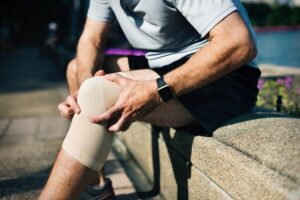5 Exciting Rehabilitation Technologies Impacting the Healthcare Industry

This September we take a look at how cutting-edge technology is speeding up rehabilitation patients’ recovery. For nurses and healthcare professionals there is no greater reward than seeing patients take the final steps to full recovery. Today the range of technology, therapy, and treatment keeps on growing.
The following are five of the latest technologies that are helping patients enrich their lives and regain their autonomy:
1) Flexible Self-Powered Knee Sensor for Rehab Monitoring
As soon as a patient flexes their knee, one material recharges another, producing electricity that powers the whole device. An antenna fixed to the knee sensor then feeds patient statistics to the medical team.
Researchers believe that, once commercialized, the devices will cost no more than $5 to $10 a piece to make. The next engineering steps are already underway to make this device smaller and more sensitive. Scientists hope that this technology will be used one day to monitor other body parts like the heart.
2) The RAPAEL Training Device
Stroke in the US is the number one cause of long-term disability affecting an estimated 795,000 people. It is also the 3rd most dangerous disease in the US. Many people face a long road to recovery needing constant physical or cognitive rehabilitation therapy.
Researchers in the neuroplasticity field are making strides with technology with great promise for stroke patients. Among the companies working in this field is Neofect- the creators of the RAPAEL Smart Pegboard.
The RAPAEL is a training device that enables stroke patients to re-develop grasp and dexterity. Stroke patients aided by high-intensity LEDs and audio cues perform dexterity and grasp enhancement exercises. Neofect have also designed games based on memory recognition and hand to eye coordination.
3) The Indego Device
Over the last decade, the Indego device has changed the lives of patients with spinal cord injuries or motor problems. The indego is not just another walker. Its gyroscopes and accelerators anticipate the wearer’s steps by just slight body movement. Once the device has developed a map of the users walking pattern, it is able to move in concert with the patient’s legs with each step. The beauty of this technology is that the patient is working their own muscles with a little help from the Indego.
The Indego also improves circulation, prevents the loss of bone density, and reduces muscle atrophy. It is also used in physical training.
4) The Hand of Hope
The Hand of Hope enables rehabilitation patients to regain hand movement. The project is a collaboration between Rehab Robotics and Honk Kong Polytechnic University.
The Hand of Hope is a hand brace that helps the stroke patient move their affected hand. The device combines advances in neurology and robotics to regain movement in their hand. A large part of this device is using repetitive hand movement exercises. This training enables the patient to relearn daily activities.
5) Prosthesis with a difference
AT&T Foundry (the product development division of AT&T) together with Hanger (a provider of prophetic services and solutions) developed a device that fits below patient knee prostheses. The device has an LT-E Modem and three sensors that measure motion and directionality data described below:
- Accelerometer- measures speed and movement force.
- Gyroscope– captures when a patient tilts or swings.
- Magnetometer– monitors the direction of patient movement much like a compass. For example, if a patient was walking, running or climbing up and down stairs.
In addition to the device developed by Foundry, Hanger developed sophisticated algorithms. These identified prostheses needing replacing and helped first-time users’ adaption to their new prostheses.
The Takeaway

By: Jonathan Gordon
